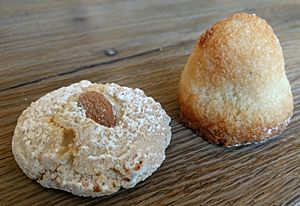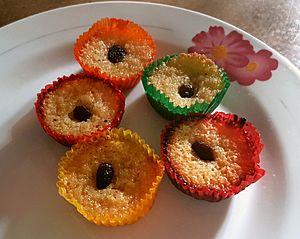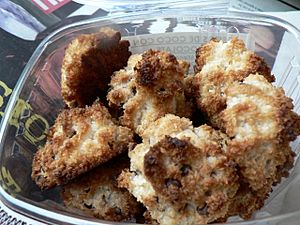Macaroon facts for kids

Almond and coconut macaroons
|
|
| Type | Cookie |
|---|---|
| Course | Snack |
| Place of origin | Italy |
| Main ingredients | Almonds (or coconuts), egg whites |
| Other information | Cream filling, different flavors other than shown |
A macaroon ( mak-ə-ROON) is a yummy, small cookie or cake. It's usually made from ground almonds or coconut, mixed with sugar and egg whites. Sometimes, people add flavors like honey, vanilla, or spices. You might also find them with colorful glacé cherries, jam, or a chocolate coating. Some recipes even use sweetened condensed milk. Macaroons are sometimes baked on thin, edible rice paper.
Contents
What's in a Name? The Word "Macaroon"
The name "macaroon" comes from an old Italian word, maccarone. This word means "paste," which makes sense because the first macaroons were made from almond paste. The Italian word itself comes from ammaccare, meaning "to crush."
Where Did Macaroons Come From?
Historians believe macaroons first appeared in an Italian monastery a very long time ago, possibly in the 700s or 800s. In 1533, monks brought these cookies to France. They were joined by the pastry chefs of Catherine de' Medici, who was the wife of King Henry II.
Later, during the French Revolution, two Benedictine nuns named Sister Marguerite and Sister Marie-Elisabeth sought safety in Nancy. To earn money for their home, they baked and sold macaroon cookies. This is how they became known as the "Macaroon Sisters."
Italian Jews later started making these cookies too. Macaroons are special because they don't have flour or leavening (they rise because of the egg whites). This means they can be eaten during the eight-day holiday of Passover. The cookie then became popular with other European Jews and was enjoyed all year round.
Recipes for macaroons can be found in cookbooks from as early as 1725. These early recipes used egg whites and almond paste. Over time, coconut was added to the ground almonds. In some recipes, coconut even replaced the almonds completely. Sometimes, Potato starch is also added to make the macaroons thicker.
Macaroon Varieties Around the World
Dominican Republic
In the Dominican Republic, macaroons are very dark. They are made by mixing grated coconut with ginger and cinnamon.
France
There are many different kinds of French macaroons. The coconut macaroon is sometimes called "" or "le rocher à la noix de coco".
Germany
Mandelhörnchen (Almond crescents) are a popular treat in Germany. They are made from a similar dough to macaroons. These cookies are shaped like a crescent moon, covered in sliced almonds, and then dipped in chocolate.
India
In India, the cities of Thoothukudi in Tamil Nadu and Mangaluru in Karnataka have their own unique macaroons. These are made with cashews and egg whites. They were inspired by the macaroons brought during colonial times.
Ireland
A macaroon chocolate bar is made by Wilton Candy in Co. Kildare, Ireland. This chocolate bar has macaroon pieces inside Irish milk chocolate. It was first made in 1937. Cleeve's Irish Confectionery also makes a macaroon chocolate bar. Its ingredients include cocoa butter, milk powder, and shredded coconut.
Italy
Ricciarelli are a soft almond macaroon from Siena. Amaretti di Saronno are usually a crunchy type from Saronno. Both are often served during special times, like Christmas.
Philippines

Philippine coconut macaroons have a special cake-like texture. They are a bit crunchy on the outside but soft, moist, and chewy inside. They are usually baked in colorful tiny cupcake wrappers and often have a raisin on top. These macaroons are very popular during holidays and special events.
Puerto Rico
In Puerto Rico, coconut macaroons are called besitos de coco, which means "little coconut kisses." You can find a few different kinds of besitos de coco on the island. The most popular ones include lemon zest and vanilla as extra ingredients.
Scotland
Macaroon chocolate bars are also popular in Scotland. Buchanan's, a long-standing family business in Greenock, makes a macaroon with Belgian chocolate and toasted coconut. Scottish Macaroon is made with a paste of potato and sugar.
Spain
The carajito is a type of macaroon made with hazelnuts and honey. It comes from the town of Salas, Asturias in northern Spain. A larger version of this cookie is often called sultana or suspiros del moro.
Turkey
Acıbadem kurabiyesi is a traditional Turkish macaroon. It is made from almonds, sugar, and egg whites. Traditional recipes include a small amount of bitter almonds, which gives the cookie its name. Since bitter almonds are hard to find, almond extract is usually used instead. These cookies are sold in almost every bakery in Turkey, as they are rarely made at home.
United Kingdom
In Britain, the traditional almond macaroon often has almond essence to make the flavor stronger. It is usually topped with an almond flake. Coconut macaroons are also very popular.
In Scotland, the Scottish macaroon has a thick, sugary center. It is covered in chocolate and roasted coconut. Long ago, they were made with leftover mashed potatoes and sugar loaf. When the macaroon bar started being sold in stores, the recipe changed. It no longer used mashed potato because it didn't last long on shelves. The modern macaroon is made from sugar, glucose, water, and egg white. These ingredients create a fondant center. This recipe was supposedly discovered by accident in Coatbridge in 1931. A candy maker named John Justice Lees reportedly messed up a chocolate fondant bar recipe. In frustration, he threw coconut over it, and that's how the first macaroon bar was made!
United States
The coconut macaroon is the most well-known type in America. Macaroons bought from stores are usually thick, moist, and sweet, and often dipped in chocolate. Macaroons made at home or by smaller bakeries are often light and fluffy. Coconut macaroons are often shaped using a pastry bag with a star-shaped tip. Macaroons made with nuts are usually shaped by hand because the dough is stiffer.
Jewish Americans
Because they are not leavened (meaning they don't rise with yeast or baking powder) and don't contain any grain, macaroons are often eaten during Passover by many Jewish Americans.
Lua error in Module:Interwiki_extra at line 84: attempt to index field 'wikibase' (a nil value).
See also
 In Spanish: Macaroon para niños
In Spanish: Macaroon para niños



